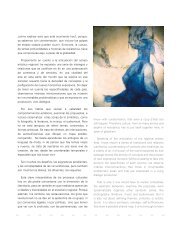yacían ensangrentados en las instalaciones carcelarias. Sesenta y ...
yacían ensangrentados en las instalaciones carcelarias. Sesenta y ...
yacían ensangrentados en las instalaciones carcelarias. Sesenta y ...
Create successful ePaper yourself
Turn your PDF publications into a flip-book with our unique Google optimized e-Paper software.
cambios tuvieron lugar simultáneam<strong>en</strong>te con su propio<br />
dev<strong>en</strong>ir histórico, y no con el de la g<strong>en</strong>eralidad del<br />
contin<strong>en</strong>te. Y es que “la propia <strong>en</strong>trada al modernismo<br />
estético ti<strong>en</strong>e <strong>en</strong> la América Latina, muchas veces,<br />
accesos profundam<strong>en</strong>te no modernos. Inevitablem<strong>en</strong>te<br />
muchas experi<strong>en</strong>cias tuvieron que postergar el anhelo<br />
de estar al día [...] al <strong>en</strong>fr<strong>en</strong>tarse a los límites y <strong>las</strong><br />
posibilidades de sus condiciones concretas” 2 .<br />
Tales circunstancias de aislami<strong>en</strong>to, <strong>en</strong>tre otras<br />
condicionantes, fueron creando abismos cada vez más<br />
profundos <strong>en</strong>tre el C<strong>en</strong>tro y el resto de la América<br />
Latina, con relación a <strong>las</strong> artes plásticas. El Istmo quedó<br />
por tanto como repres<strong>en</strong>tante de una cultura, aj<strong>en</strong>a<br />
a <strong>las</strong> singularidades que a mediados del siglo XX iban<br />
caracterizando al «arte latinoamericano». De este modo,<br />
C<strong>en</strong>troamérica quedaría unida al resto del contin<strong>en</strong>te<br />
sólo por estereotipadas imág<strong>en</strong>es id<strong>en</strong>titarias basadas<br />
<strong>en</strong> elem<strong>en</strong>tos comunes. Lo “latinoamericano” como un<br />
seudónimo, se convirtió <strong>en</strong> una especie de trampa, una<br />
emboscada casi infranqueable, sería el filtro que a manera<br />
de camisa de fuerza deberían utilizar no pocos creadores<br />
de la época para ganar <strong>en</strong> visibilidad desde propuestas<br />
indudablem<strong>en</strong>te “modernas”. Y cuando me refiero a<br />
lo “latinoamericano” m<strong>en</strong>cionado anteriorm<strong>en</strong>te, me<br />
refiero a un tipo de arte que:<br />
“…también surge de <strong>las</strong> distorsiones que produc<strong>en</strong><br />
<strong>las</strong> sucesivas copias, de <strong>las</strong> dificultades <strong>en</strong> adoptar<br />
signos que supon<strong>en</strong> técnicas, razones y s<strong>en</strong>sibilidades<br />
difer<strong>en</strong>tes y, por supuesto, del consci<strong>en</strong>te int<strong>en</strong>to de<br />
adulterar el s<strong>en</strong>tido del prototipo. Así, muchas obras<br />
destinadas a constituir degradados trasuntos de los<br />
modelos metropolitanos recuperan su originalidad <strong>en</strong><br />
cuanto por error, ineficacia o voluntad transgresora<br />
traicionan el rumbo del s<strong>en</strong>tido primero”. 3<br />
En el campo específico de <strong>las</strong> artes visuales este<br />
calificativo surgió como un concepto paralelo, <strong>en</strong> primera<br />
2 Ibidem. Pp 16<br />
Ibidem, p.16.<br />
had to postpone their desire to stay up-to-date [...]<br />
confronted with the limits and the possibilities of their<br />
specific conditions.” 2<br />
Such isolating circumstances, among other<br />
determining factors, created deeper and deeper<br />
gaps betwe<strong>en</strong> C<strong>en</strong>tral America and the rest of the<br />
contin<strong>en</strong>t in regard to visual arts. The Isthmus remained<br />
a repres<strong>en</strong>tative of a culture disconnected from the<br />
peculiarities that by the middle of the tw<strong>en</strong>tieth c<strong>en</strong>tury<br />
defined “Latin American art.”<br />
This way, C<strong>en</strong>tral America stayed joined to the rest<br />
of the contin<strong>en</strong>t only by the images of a stereotypical<br />
id<strong>en</strong>tity based on supposedly common elem<strong>en</strong>ts. “Latin<br />
American art” as a pseudonym became a trap of sorts,<br />
an almost unavoidable ambush; it became the filter that,<br />
as a straitjacket, more than a few undoubtedly “modern”<br />
artists of that era had to adjust to gain visibility. And<br />
wh<strong>en</strong> I speak of the aforem<strong>en</strong>tioned “Latin American<br />
id<strong>en</strong>tity,” I am referring to a type of art that<br />
“…also originates in the distortions produced by a<br />
succession of copies, the difficulties in adopting<br />
signs that mean differ<strong>en</strong>t techniques, reasons, and<br />
s<strong>en</strong>sibilities, and, of course, the conscious attempt<br />
of adulterate the meaning of the prototype. This way,<br />
many works of art int<strong>en</strong>ded to constitute degraded<br />
imitations of the metropolitan models recover<br />
their originality as soon as they (be it by mistake,<br />
ineffici<strong>en</strong>cy or transgression) betray the course of<br />
their original meaning”. 3<br />
In the specific field of visual arts, the expression “Latin<br />
American id<strong>en</strong>tity” originated as a parallel concept,<br />
firstly, to “European id<strong>en</strong>tity.” Both are a part of those<br />
dichotomies that co-existed in Modernity, opposites<br />
which served to describe the transgressions of a local<br />
3 Escobar, Ticio: 1999, «Acerca de la modernidad y del arte: cuestiones finiseculares». Casa de <strong>las</strong> Américas, La Habana, No. 214, <strong>en</strong>ero-marzo, pp 115.<br />
Escobar, Ticio: 1999, “Acerca de la modernidad y del arte: cuestiones finiseculares.” Casa de <strong>las</strong> Américas, Havana, No. 214, January-March, p.115.<br />
30 32 34 36 38 40 42 44 46 48 50 52 54 56



